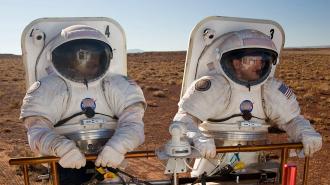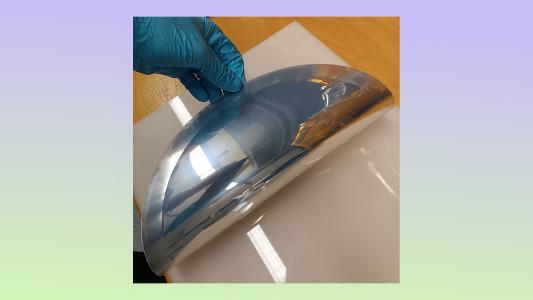This summer, four faux astronauts will enter a simulated Mars base in Texas to help NASA understand what might happen to people during extended missions to the Red Planet — and we just got our first look at their 3D-printed digs.
The challenge: NASA estimates that it’ll take about nine months just for astronauts to reach Mars, and counting the time they spend exploring the planet and flying home, they’re likely to be off-world for two to three years.
Besides Earth, the moon is the only other planetary object humans have set foot on, and the longest mission on its surface lasted just over three days. The longest ISS mission, meanwhile, was just under a year, and most ISS missions last just six months.
That means we don’t really know how such a long trip away from Earth might affect the mental and physical health of Mars astronauts — and unlike visitors to the moon or ISS, there is no way to swiftly retrieve Mars astronauts if things go wrong.
Simulated Mars base: To help it anticipate how best to support astronauts on Mars missions, NASA has built a simulated Mars base — Mars Dune Alpha — at its Johnson Space Center in Texas.
“Simulations on Earth will help us understand and counter the physical and mental challenges astronauts will face before they go.”
Grace Douglas
This summer, a group of four people will move into the base for a year-long stay during which they will be exposed to many of the same stressors astronauts will face on Mars, including isolation, limited resources, communication delays, and heavy workloads.
The agency plans to conduct three of these year-long simulations as part of its Crew Health and Performance Exploration Analog (CHAPEA), with the second and third missions kicking off in 2025 and 2026, respectively.
“The analog is critical for testing solutions to meet the complex needs of living on the Martian surface,” said Grace Douglas, lead scientist for NASA’s Advanced Food Technology research effort. “Simulations on Earth will help us understand and counter the physical and mental challenges astronauts will face before they go.”
First look: On April 11, NASA gave reporters a first look at its simulated Mars base, which consists of a 1,700-square-foot indoor space and a 1,200-square-foot outdoor area, all enclosed within an inflatable bubble inside a warehouse.
The walls of Mars Dune Alpha’s indoor space were 3D-printed by ICON — the same Texas-based construction company that’s developing a 3D printer that could actually be used to build habitats on the moon and Mars.
Within those walls are four private quarters for sleeping, two bathrooms, and a lounge area that includes board games, a PlayStation 3, and a Super Nintendo. There are also several workstations, a medical station, a kitchen space, and a vertical farm setup.
Before exiting Mars Dune Alpha’s indoor area, inhabitants will don spacesuits and pass through an airlock. The outdoor part of the simulated Mars base features a floor of red sand and equipment, such as solar panels, that will need to be maintained during the mission.
There are also rigs that will suspend crew members above treadmills — they can don VR headsets and walk for miles across Mars while feeling the effects of its reduced gravity.
“We thought through a few different types of spacewalks that we thought would be realistic to what astronauts would do on the surface of Mars,” said Raina MacLeod, CHAPEA deputy project manager. “We would have them do geology work, and then they probably would do some building tasks, and then also exploration.”

During the simulation, crew members will also get a chance to send a rover and helicopter-like drone on surveying and sample-retrieval missions — and not just because NASA plans to have Mars astronauts actually work with those types of robots.
“The robotics element is a very interesting activity that we are including for our crew,” said MacLeod. “It’s always good to have really stimulating tasks, especially on a long-duration analog study to keep the crew excited.”
Looking ahead: NASA has yet to announce the names of the four people expected to move into its simulated Mars base this summer, but it’s using the same selection criteria for participants as it does for astronauts.
NASA doesn’t seem poised to pay the crew in nearly the same way, though.
While it says compensation “is available” for participating in CHAPEA, it also regularly refers to the crew as “volunteers” — suggesting that those who end up dedicating a year of their lives to “living” on Mars will be doing so for the love of a challenge.
We’d love to hear from you! If you have a comment about this article or if you have a tip for a future Freethink story, please email us at [email protected].






